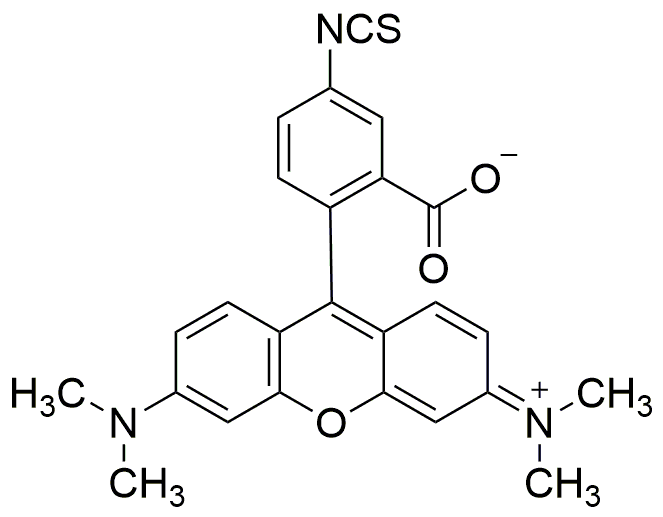Tetramethylrhodamine-5-isothiocyanate is widely utilized in research focused on:
- Fluorescent Labeling: This compound is commonly used to label proteins and antibodies in various biological assays, enhancing visualization under fluorescence microscopy.
- Cell Imaging: It serves as a vital tool in cell biology for tracking cellular processes, enabling researchers to study live cells and their interactions in real-time.
- Diagnostics: In medical research, it plays a role in developing diagnostic assays, particularly in detecting specific biomolecules associated with diseases.
- Environmental Monitoring: The compound is employed in environmental science to trace pollutants and study their effects on ecosystems, thanks to its high sensitivity and stability.
- Drug Development: It aids in the pharmaceutical industry by facilitating the study of drug interactions and mechanisms, providing insights that can lead to more effective therapies.
General Information
Properties
Safety and Regulations
Applications
Tetramethylrhodamine-5-isothiocyanate is widely utilized in research focused on:
- Fluorescent Labeling: This compound is commonly used to label proteins and antibodies in various biological assays, enhancing visualization under fluorescence microscopy.
- Cell Imaging: It serves as a vital tool in cell biology for tracking cellular processes, enabling researchers to study live cells and their interactions in real-time.
- Diagnostics: In medical research, it plays a role in developing diagnostic assays, particularly in detecting specific biomolecules associated with diseases.
- Environmental Monitoring: The compound is employed in environmental science to trace pollutants and study their effects on ecosystems, thanks to its high sensitivity and stability.
- Drug Development: It aids in the pharmaceutical industry by facilitating the study of drug interactions and mechanisms, providing insights that can lead to more effective therapies.
Documents
Safety Data Sheets (SDS)
The SDS provides comprehensive safety information on handling, storage, and disposal of the product.
Product Specification (PS)
The PS provides a comprehensive breakdown of the product’s properties, including chemical composition, physical state, purity, and storage requirements. It also details acceptable quality ranges and the product's intended applications.
Certificates of Analysis (COA)
Search for Certificates of Analysis (COA) by entering the products Lot Number. Lot and Batch Numbers can be found on a product’s label following the words ‘Lot’ or ‘Batch’.
*Catalog Number
*Lot Number
Certificates Of Origin (COO)
This COO confirms the country where the product was manufactured, and also details the materials and components used in it and whether it is derived from natural, synthetic, or other specific sources. This certificate may be required for customs, trade, and regulatory compliance.
*Catalog Number
*Lot Number
Safety Data Sheets (SDS)
The SDS provides comprehensive safety information on handling, storage, and disposal of the product.
DownloadProduct Specification (PS)
The PS provides a comprehensive breakdown of the product’s properties, including chemical composition, physical state, purity, and storage requirements. It also details acceptable quality ranges and the product's intended applications.
DownloadCertificates of Analysis (COA)
Search for Certificates of Analysis (COA) by entering the products Lot Number. Lot and Batch Numbers can be found on a product’s label following the words ‘Lot’ or ‘Batch’.
*Catalog Number
*Lot Number
Certificates Of Origin (COO)
This COO confirms the country where the product was manufactured, and also details the materials and components used in it and whether it is derived from natural, synthetic, or other specific sources. This certificate may be required for customs, trade, and regulatory compliance.


